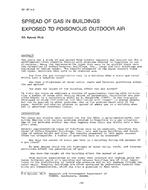
NY-87-14-5 — Spread of Gas in Buildings Exposed to Poisonous Outdoor Air
- Comments Off on NY-87-14-5 — Spread of Gas in Buildings Exposed to Poisonous Outdoor Air
- ASHRAE
Two years ago a study of gas spread from outdoor exposure was carried out for a governmental-level committe dealing with problems related to hospitals in war situations. Among the representative types that were to be studied there were two categories of modern hospital buildings, viz., large and tall buildings and buildings of medium height. The results presented in the paper concern these two types. Questions that were to be answered are:
How does the gas concentration vary in a building when a toxic gas cloud drifts into a hospital area?
How does airtightness of outer walls, roofs and internal partitions affect the gas spread?
How does the height of the building affect the gas spread?
To limit the costs we combined a minimum of experimental testing with calculating a number of cases with varying values of parameters. Calculation was possible thanks to a calculation model by S. Bergström (1985). It was orginally developed to study infiltration and ventilation with respect to energy demand, but can be applied to other problems. One is the problem dealt with in the paper. Another and similar problem is spread of smoke gas in a building when gas is generated somewhere indoors.
Units: SI
Citation: Symposium, ASHRAE Transactions, 1987, vol. 93, pt. 1, New York, NY
Product Details
- Published:
- 1987
- Number of Pages:
- 12
- File Size:
- 1 file , 880 KB
- Product Code(s):
- D-NY-87-14-5

